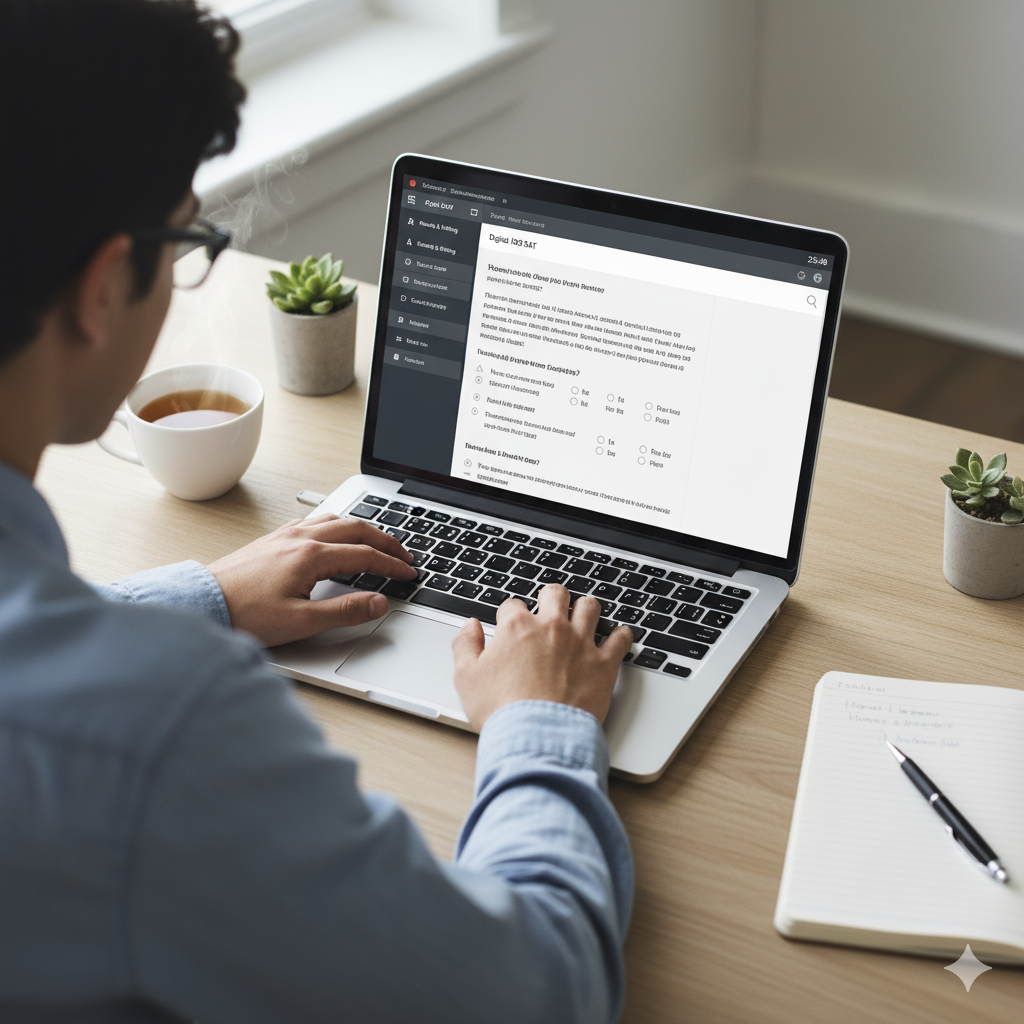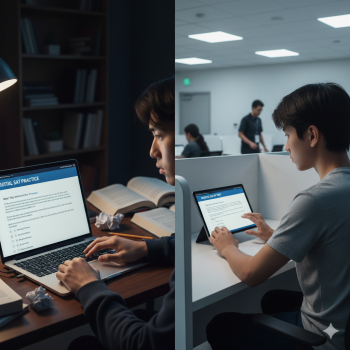Introduction: You Can Prepare—Even Offline
Picture this: it’s Saturday morning, you’ve carved out three hours to study, and your Wi‑Fi drops. Heart sinks. But before panic takes over, breathe. Preparing for the Digital SAT without constant internet is not only possible—it can be smart, focused, and even liberating.
This guide is written for students who have limited or unreliable internet access, share devices with family members, or simply prefer concentrated, offline study time. You’ll find practical study plans, concrete offline resources (what to print, what to carry), time management hacks, ways to simulate the digital experience, and thoughtful strategies for keeping momentum. I’ll also point out how personalized, 1‑on‑1 help—like Sparkl’s tailored tutoring—can slot into this approach when online time is available or when you have limited, scheduled access.
Why offline prep can work (and sometimes work better)
Many students assume that the best SAT preparation must be online: adaptive practice tests, video lessons, instant analytics. Those are great tools—but they’re not the only path to success. Offline studying encourages deeper focus, reduces distractions, and forces active techniques that build retention: handwriting notes, timed pencil‑and‑paper practice, and deliberate review sessions.
Here’s what offline prep gives you:
- Fewer digital distractions—no endless tabs, no notifications.
- Stronger test‑taking stamina built through physical, timed practice tests.
- More intentional review—when you write explanations in your own words, you understand the logic rather than skim a solution.
- Practical familiarity with printed problem formats—useful for those approved to test on paper or for students who will borrow a device on test day and want to practice without screen fatigue.
Step 1: Gather the essential offline materials
The first step is inventory: assemble the tangible tools you’ll need. Focus on official materials where possible; they give the clearest sense of question style and difficulty.
What to download or print (when you have access)
- Official full‑length paper practice tests (PDFs) and scoring guides from the College Board. These include answer explanations—print them if you can.
- Linear (nonadaptive) practice forms if you might be approved to test on paper; these are longer but terrific stamina builders.
- Bluebook practice test preview notes (if you can access Bluebook briefly, screenshot the test preview instructions and tools overview for offline review).
- Practice question packets: collect math problem sets, grammar drills, and reading passages and print them into smaller packets (20–30 questions) for quick practice sessions.
- A notebook or binder for timed corrections, vocabulary logs, and strategy notes.
If you have only occasional internet—save everything at once to a flash drive or print multiple copies at school, the library, or a community center.
Step 2: Build an offline study schedule that fits your life
Structure beats hours. A realistic schedule prevents burnout and turns small windows of internet access into high‑value sessions.
Weekly plan template (for students with limited internet)
| Day | Focus | Offline Activity | Optional Short Online Task |
|---|---|---|---|
| Monday | Math concepts | 30–60 min worksheet (algebra/geometry drills) | Sync progress with tutor or upload practice answers |
| Tuesday | Reading comprehension | 1 passage + timed questions, annotate on paper | Quick video lesson on passage strategy (if available) |
| Wednesday | Writing & language | Grammar packet: 20 questions, explain corrections in notebook | Review answer explanations online (if possible) |
| Thursday | Mixed review | Short mixed set (10–15 questions) & error log update | Check practice test scores or ask tutor for tailored plan |
| Friday | Timed practice | Half‑section timed (30–60 min) under test conditions | Upload or photograph answers for online scoring (optional) |
| Weekend | Full practice or deep review | Full‑length paper practice test every 2–3 weeks | Use online time to take an adaptive Bluebook practice if you want |
This template is intentionally flexible—tweak the session lengths to match your attention span and school responsibilities.
Step 3: Simulate the digital test while offline
Even if you study on paper, it helps to simulate the digital experience so the format isn’t a surprise on test day. You can approximate the digital test’s pacing and navigation with simple offline habits.
- Use a timer and restrict yourself to one section at a time. The digital SAT is sectional, and bluebook practice shows you can move within a section—practice that behavior on paper by only allowing forward movement within the time block.
- Practice the calculator policy: use whatever calculator you plan to use on test day and practice key entry, memory functions, and common keystrokes on a small calculator you can carry.
- Simulate answer marking: fill bubbles on practice PDFs or write answer sheets. This cuts down on time lost by changing marking methods on test day.
- Practice screen‑less focus: to mimic reading on a screen, try reading printed passages for a similar duration while sitting upright at a desk to build similar eye and posture stamina.
Step 4: Make the most of limited online time
Think of online access as precious fuel. When you do get connected, use that time strategically:
- Download and save PDFs for later (practice tests, scoring guides, and answer explanations).
- Upload recent practice results to get feedback from a tutor or to record progress in an online tracker.
- Ask for targeted help—send a short list of 3–5 problem types you struggled with instead of long, unspecific messages.
- Schedule a brief live tutoring session (20–40 minutes) focused on your top challenge. This is where Sparkl’s personalized tutoring really shines: their 1‑on‑1 guidance can be scheduled to match your online windows, and tutors can create tailored study plans that you can execute offline.
Step 5: Active review techniques for deeper learning
Active review is the difference between repeating errors and actually improving. When you review incorrect answers, do it like a detective:
- Write down the exact mistake type (e.g., misunderstood passage main idea, arithmetic careless error, wrong grammar rule applied).
- Explain the correct answer in one to two sentences in your own words.
- Create a mini‑problem that targets the same mistake and solve it immediately.
- Track recurring errors in an error log and prioritize the most frequent ones in future practice blocks.
Keep a two‑column notebook page: left column = question and your original reasoning; right column = correction and short rule. This habit permanently rewires how you approach similar questions later.
Step 6: Practical offline drills by section
Reading
Reading offline is where many students actually benefit—printed passages discourage skimming and force careful annotation.
- Annotate actively: underline main ideas, circle keywords, jot quick labels (purpose, tone, evidence) in the margins.
- Practice question triage: first answer global questions (main idea, tone), then detail questions, then inference.
- Time practice: do one passage in 20–22 minutes, then check accuracy and identify where you spent too much time.
Writing & Language
Grammar and expression questions respond very well to rule‑drill practice.
- Create flashcards of common grammar rules (subject‑verb agreement, verb tense, comma rules) and practice 5 cards daily.
- Rewrite sentences: for each grammar question you miss, rewrite the sentence correctly and then write why the other answer choices are wrong.
Math
Math is a skills game that rewards repetitive, focused practice.
- Carry a set of formula cards (algebra, geometry facts) and test yourself during short gaps in the day.
- Practice mental math and shortcut methods so you rely less on calculators for small computations.
- When you miss a problem, isolate whether the error was conceptual, arithmetic, or strategy—treat each separately in review.
Step 7: Use libraries, schools, and community centers
Public institutions are an underused lifeline. Libraries often have PCs, printers, scanners, and quiet rooms; schools and community centers sometimes offer printing services or study spaces. Build a list of local resources and their hourly windows so you can plan those longer practice sessions.
Step 8: Low‑tech tools that make a big difference
Sometimes the simplest tools are the most effective. Invest in or borrow a few reliable, low‑cost items:
- A reliable scientific calculator (same model as you’ll use on test day).
- Multiple pencils, a good eraser, and a small timer or stopwatch.
- A dedicated binder with plastic sleeves for practice test pages and a separate “error log” notebook.
- Index cards for formulas and grammar rules—compact and portable.
Step 9: How to get targeted help with limited connectivity
When internet access is rare, use it smartly. Book short, focused tutoring sessions to discuss a handful of questions or to set a tailored offline plan. Sparkl’s personalized tutoring model—1‑on‑1 guidance, customized study plans, and AI‑driven insights—can be particularly effective: a tutor can diagnose the most important weaknesses during a brief online meeting, then leave you with printable, step‑by‑step work to complete offline.
Suggested use of a short online tutoring session:
- Bring 10 sample problems you struggled with (photos or PDFs) and ask the tutor to prioritize 3 action items.
- Ask for a printable mini‑plan: a week‑by‑week worksheet packet, targeted drills, and one timed practice to take offline.
- Schedule a quick follow‑up to check progress and adjust the plan.
Step 10: Realistic progress measures and motivation
Progress doesn’t require daily online dashboards. Use simple, repeatable metrics so you can measure improvement offline:
- Track accuracy on specific question types (e.g., linear equations, evidence‑based reading questions) weekly in a table.
- Record time per passage or per math problem type to measure speed gains.
- Schedule full practice tests every 2–3 weeks and chart your scaled section scores on paper to view trajectory.

Here’s a sample offline progress tracking table you can recreate in your notebook:
| Week | Reading Accuracy (%) | Writing Accuracy (%) | Math Accuracy (%) | Timed Practice (minutes) | Notes/Action |
|---|---|---|---|---|---|
| 1 | 68 | 72 | 63 | Full test: 4 hrs | Focus: algebra errors |
| 3 | 75 | 78 | 70 | Half test: 2 hrs | Added daily formula cards |
| 6 | 82 | 85 | 78 | Full test: 4 hrs | Improved pacing, fewer careless errors |
Common pitfalls and how to avoid them
Studying offline has its traps. Here are common issues and practical fixes:
- Pitfall: Cramming with low‑quality printed questions. Fix: Prioritize official practice tests and vetted PDFs—quality matters more than quantity.
- Pitfall: Reviewing without understanding. Fix: Always explain why each answer is right or wrong in your own words.
- Pitfall: Losing momentum. Fix: Set small weekly goals and celebrate tiny wins—an extra practice score point is progress.
How to prepare for test day logistics with limited internet
Test day logistics often require being online for registration or downloading Bluebook. If your access is limited, plan ahead:
- Reserve a time at a library or school to complete online steps: registration, Bluebook download, or device checks.
- If you don’t own an approved device, research device lending policies early and schedule a borrowing window.
- Print or save required ID info, test center directions, and arrival instructions so you’re not dependent on live access the morning of the test.
Final tips: mindset, rest, and test‑day confidence
Preparation is as much mental as it is technical. Limited internet doesn’t mean limited opportunity. Many high‑scoring students studied primarily offline—what mattered was consistent practice, targeted review, and smart use of resources.
- Rest: Don’t sacrifice sleep to cram. Your brain consolidates learning while you sleep—8 hours matters.
- Focus on clarity: one clear strategy for each problem type beats scattered, half‑learned tricks.
- Use short offline warm‑ups on test day: 10 minutes of breathing, a quick review of key formulas and a short vocabulary card deck.
When to get extra help—and how to get it with limited internet
If you feel stuck despite disciplined offline work, targeted help can unlock rapid improvement. Even with limited connectivity you can:
- Schedule weekly short online tutoring sessions focused on one challenge area. Use the session to get a prioritized plan and printable drills you can complete offline.
- Send scanned or photographed practice pages to a tutor ahead of a scheduled call so feedback is precise and efficient.
Sparkl’s personalized tutoring approach is designed for students with varied access: their tutors can provide focused, 1‑on‑1 sessions that fit brief online windows, build tailored study plans you can execute offline, and deliver AI‑driven insights to pinpoint weaknesses. When used strategically, a few targeted sessions can multiply the effectiveness of your offline hours.
Quick checklist to get started this week
- Download and print one official full‑length practice test and its scoring guide.
- Create a small binder: practice tests, answer keys, error log notebook, formula cards.
- Set two weekly online windows (even 30 minutes each) to download new materials and check in with a tutor or self‑score.
- Schedule your first timed half‑section practice and review it using the detective method.

Closing: You’re more prepared than you think
Limited internet access is a challenge, but it’s also an opportunity to build focused, distraction‑free habits that many students overlook. With official printed practice materials, a clear offline schedule, targeted review techniques, and occasional high‑value online tutoring sessions—like those offered through Sparkl—you can make every study hour count.
Start small, track progress, and refine your plan. The SAT isn’t a test of how many videos you watched; it’s a test of how well you understand and apply concepts under pressure. Offline study builds that muscle. Keep going—your preparation is more than your internet signal.
Want a printable starter pack?
Use your next internet window to download one official full‑length practice test, its scoring guide, and an answer explanation PDF. Print or save them to a flash drive and you’ll have the core tools you need for the next month of focused, offline preparation.
Good luck—and study well.
With smart planning and steady effort, you can walk into test day confident and prepared, internet or no internet.



















No Comments
Leave a comment Cancel